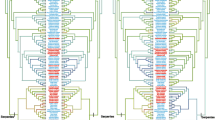Summary
Recent studies suggest that lower survival among gravid squamate reptiles may be partially the result of decreased locomotor ability during gestation. In this study, we compared the speed and endurance of female garter snakes (Thamnophis marcianus), before, during, and after pregnancy. Gravid snakes had significantly lower locomotor performance than did non-gravid females, and performance varied among stages of gestation, reaching a minimum 0–6 weeks prior to parturition. Both number of offspring and relative clutch mass were inversely correlated with locomotor performance; as females increased these traits, locomotor ability decreased. If reduced locomotor performance results in greater risk of predation and/or lowered foraging ability, then natural selection (operating via differential mortality or feeding rates of gravid females) may result in important constraints on both clutch size and relative clutch mass in squamates.
Similar content being viewed by others
References
Andren C (1982) Effect of prey density on reproduction, foraging and other activities in the adder, Vipera berus. Amphibia-Reptilia 3:81–96
Andren C (1985) Risk of predation in male and female adders, Vipera berus (Linne). Amphibia-Reptilia 6:203–206
Arnold SJ, Bennett AF (1984) Behavioural variation in natural populations. III: Antipredator displays in the garter snake Thamnophis radix. Anim Behav 32:1108–1118
Bauwens D, Thoen C (1981) Escape tactics and vulnerability to predation associated with reproduction in the lizard Lacerta vivipard. J Anim Ecol 50:733–743
Birchard GF, Black CP, Schuett GW, Black V (1984) Influence of pregnancy on oxygen consumption, heart rate and hematology in the garter snake: Implications for the “cost of reproduction” in live bearing reptiles. Comp Biochem Physiol 77A:519–523
Bull JJ, Shine R (1979) Iteroparous animals that skip opportunities for reproduction. Am Nat 114:296–303
Fitch HS (1987) Collecting and life-history techniques. In: Seigel RA, Collins JT, Novak SS (eds) Snakes: Ecology and Evolutionary Biology, Macmillan Publ Co. New York, pp 143–164
Ford NB, Shuttlesworth GA (1986) Effects of variation in food intake on locomotory performance of juvenile garter snakes. Copeia 1986:999–1001
Garland T Jr (1985) Ontogenetic and individual variation in size, shape and speed in the Australian agamid lizard Amphibolorus nuchalis. J Zool Lond 207:425–439
Garland T Jr, Arnold SJ (1983) Effects of a full stomach on locomotory performance of juvenile garter snakes (Thamnophis elegans) Copeia 1983:1092–1096
Garland T Jr, Else PL (1987) Seasonal, sexual, and individual variation in endurance and activity metabolism in lizards. Am J Physiol 252:R439-R449
Gregory PT, Stewart KW (1975) Long-distance dispersal and feeding strategy of the red-sided garter snake (Thamnophis sirtalis parietalis) in the Interlake of Manitoba. Can J Zool 53:238–245
Huey RB, Bennett AF, John-Alder H, Nagy K (1984) Locomotor capacity and foraging behaviour of Kalahari lacertid lizards. Anim Behav 32:41–50
Madsen T (1987) Costs of reproduction and female life-history tactics in a population of grass snakes, Natrix natrix, in southern Sweden. Oikos 49:129–132
Prestt I (1971) An ecological study of the viper (Vipera berus) in southern Britain. J Zool Lond 164:373–418
Seigel RA, Fitch HS (1984) Ecological patterns of relative clutch mass in snakes. Oecologia (Berlin) 61:293–301
Semlitsch RD, Gibbons JW (1978) Reprodcutive allocation in the brown water snake, Natrix taxispilota. Copeia 1978:721–723
Shine R (1980) “Costs” of reproduction in reptiles. Oecologia (Berlin) 46:92–100
Shine R (1986) Ecology of a low-energy specialist: Food habits and reproductive biology of the Arafura filesnake (Acrochordidae). Copeia 1986:424–437
Sokal RR, Rohlf FJ (1981) Biometry. 2nd Ed., WH Freeman Co, San Francisco
Vitt LJ (1981) Lizard reproduction: Habitat specificity and constraints on relative clutch mass. Am Nat 117:506–514
Vitt LJ, Congdon JD (1978) Body shape, reproductive effort and relative clutch mass in lizards: Resolution of a paradox. Am Nat 112:595–608
Vitt LJ, Price HJ (1982) Ecological and evolutionary determinants of relative clutch mass in lizards. Herpetologica 38:237–255
Volsøe H (1944) Structure and seasonal variation of the male reproductive organs of Vipera berus (L.). Spoila Zool Mus Haun 51:1–157
Wilkinson L (1984) SYSTAT: The system for statistics. Systat Inc, Evanston, Illinois
Williams GC (1966) Adaptation and natural selection. Princeton Univ. Press, Princeton, New Jersey
Author information
Authors and Affiliations
Rights and permissions
About this article
Cite this article
Seigel, R.A., Huggins, M.M. & Ford, N.B. Reduction in locomotor ability as a cost of reproduction in gravid snakes. Oecologia 73, 481–485 (1987). https://doi.org/10.1007/BF00379404
Received:
Issue Date:
DOI: https://doi.org/10.1007/BF00379404




